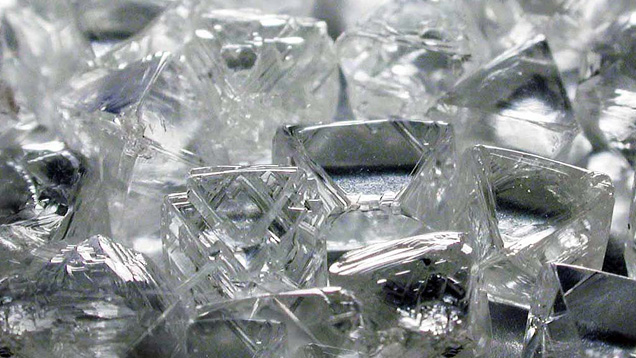De Beers Reduces Rough
Prices – Too Little?
May 19, 2015

The May sight totaled about $450 million, according to reports – way down from the $690 million of the March sight (there was no April sight) when clients walked away from an estimated 30-40% of their allocations because they were not profitable to cut and financing was expensive and difficult to come by. The refusal rate of the May sight, the first of the new 30-month term, was reportedly below 10%.
Diamond manufacturers had mixed views on the sight. Some believe the adjustment from De Beers was inadequate, noting that polished prices declined much more than 3% since the beginning of the year. The squeeze remains because polished prices have slipped much more than that since January. Others point out that lowering rough prices too much will compromise the value of existing rough inventories, further reducing sightholders’ available credit.
Alrosa reportedly will lower prices by a similar amount at its next sale in late May.
Diamonds Treatments Keep Evolving
In 1999 GIA embarked on a crash research program to detect natural diamonds that had been treated by the high pressure, high temperature (HPHT) to improve their color after they were introduced into the marketplace. On May 12, GIA informed the trade that approximately 500 colorless to near-colorless diamonds submitted to its Ramat Gan grading laboratory had potentially been subjected to an undisclosed temporary treatment. The Institute notified the appropriate trade bodies, terminated client agreements with several diamond firms that had submitted the stones in question, and posted the report numbers of the potentially treated stones.
The World Federation of Diamond Bourses and other trade organizations can impose sanctions, including fines and expulsion from member diamond bourses, on dealers who intentionally attempt to sell treated or synthetic diamonds without disclosure.
More Diamond News
Blue Nile, the leading online diamond seller, reported that its first quarter diamond sales fell short of its goal, coming in just 2.6% higher than the comparable period last year. The company had been reporting double-digit growth for much of its 15-year existence. A sharp decline in high ticket sales, especially those over $50,000, was responsible for the sales short fall, the company said. Blue Nile reported that its engagement ring business − its mainstay − was flat for the quarter, but that fashion jewelry and international sales did see an upturn.
Auctions
More price records fell again with Sotheby’s May 12 Geneva Magnificent Jewelry auction, which totaled more than $160.9 million, the highest total ever achieved for a jewelry sale. The highlight was the 25.59 carat (ct.) “Sunrise Ruby” by Cartier that drew a winning bid of $30.38 million – nearly $1.2 million per carat and nearly twice its pre-sale estimate. The Burmese ruby was unheated and commanded the highest price for a ruby ever achieved at auction.
Other notable sales at the May 12 Sotheby’s auction included:
- An 8.72 ct. GIA-graded Fancy Vivid pink diamond believed to have belonged to Princess Mathilde, the niece of Napoleon Bonaparte, which old for just over $16 million; about $1.8 million per carat.
- A natural pearl strand containing 78 pearls and a 4.39 ct. marquise shape diamond that went for just under $7 million.
- A 30.23 ct. Kashmir sapphire set by Cartier with 42.35 carats of diamonds, which drew a top bid of $6.1 million.
An Asian buyer purchased a 55.52 ct. GIA-graded D IF pear shape diamond for $9 million, $162,000 per carat, while a single strand of 19th century natural pearl necklace sold to a dealer for $3.9 million. The pearls ranged from 7.8 mm to 11 mm.
Sotheby’s April 21 auction in New York was highlighted by the sale of a 100.2 ct. GIA-graded Type IIa D IF cut-cornered rectangular shape diamond that sold for $22 million ($220,000 per carat), square in the middle of its pre-sale estimate. This was a strong price in light of the pressures on top gems and other luxury items this year. In addition, a Type IIa 22.3 ct. marquise shape D IF diamond sold for $3.3 million (about $150,000 per carat).
About The Author
Russell Shor is senior industry analyst at GIA in Carlsbad.
.jpg)


